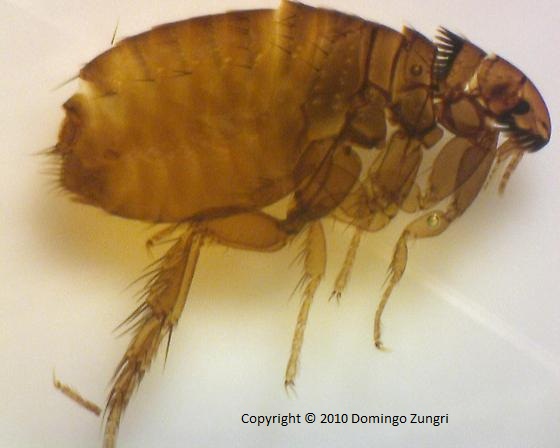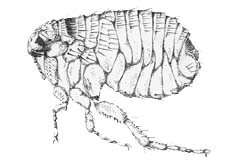Adaptation & Nutrition
Discussed below are key features that can help identify the cat flea.
-
Fleas are reddish brown, oval, and wingless.
-
The body of the flea is extremely thin so that it can move easily through the fur of their host. (Boro 1970)
-
They have enlarged coxae, or hip joint, enabling them to make leaps up to a foot and sometimes even more. This allows them to transfer from host to host more easily. (O'Toole 1986)
-
Claws at the tips of legs allow them to remain attached to their host even if the host were to shake or scratch at them. (Purdue University 2008)
-
Females deposit their eggs in animal beddings allowing their larvae to attach directly to a host when they hatch. (Rust 2005)
-
Has a genal and protonal comb (combs are rows of spines on the posterior region of the head). (Borro 1970)
-
Its bite can be quite a nuisance to its host. This is due to the fleas saliva entering the skin of the host which contains chemicals that trigger an immune response which causes the area to become swollen and extremely itchy. However, it is important to not itch this area as further scratching can lead to infection and/or disease. (Purdue University 2008)

All of these adaptations are used mainly to feed. Adult cat fleas feed predominantly on their hosts blood which, for adult females, can average 13μl/day which equates to about 15 times its bodyweight. The larval stage eats primarily organic matter, in particular adult feces that fall to the ground or through cannibalism of non-fertile eggs. (Rust and Dryden 1997) Through their adaptations they are able to thrive and unfortunately it is often on your pet or in your home. Precautionary measure should be taken to prevent your pet from becoming infested with cat fleas with the easiest being through just monitoring your pet and at the first sign of infestation using specialized insecticides to rid them from your pet. To learn more see Flea Management.
